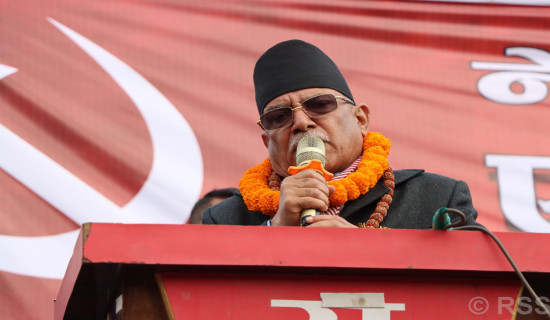- Friday, 2 January 2026
The Silence Beneath Conservation
Nepal has emerged as a global leader in wildlife conservation in recent decades, achieving significant milestones in protecting endangered species such as tigers, rhinos, and snow leopards. Nepal's conservation journey began with the formulation of the National Parks and Wildlife Conservation Act of 1973, which led to the establishment of Chitwan National Park. Since then, the country has expanded its protected areas to 12 national parks, one wildlife reserve, one hunting reserve, six conservation areas, and 13 buffer zones. In the meantime, the country made headlines by doubling its tiger population from 121 in 2009 to 355 in 2022, thus becoming the first country in the world to set such a record, as reported by the National Trust for Nature Conservation (NTNC, 2022). Similarly, the National Rhino Count Report 2021 indicates a whopping 16 per cent (645-752) increase in the rhino population between 2015 and 2021 in the country, as reported by the National Rhino Count Report, 2021. However, the impressive gains in wildlife conservation that garnered international acclaim come with a cost that is particularly borne by the indigenous communities living at the outskirts of the protected areas. We can confidently acknowledge the expenses associated with "The Cost of Conservation."
Echoing crisis
Amid these conservation successes lies a sobering reality that carries the peril of the indigenous communities residing in the buffer zones of protected areas. The risk is observed in the form of severe human-wildlife conflicts that cause significant disruption in these people's lives.
Take Bahun village in the Golaghat area of Chitwan, for example. Once crowded with delighted residents, this village now appears desolate, with a noticeable absence of people. The primary cause behind this is the conflict between humans and wildlife. Disputes in this village are particularly observed in the form of elephants troubling people, which has led the rate of human-elephant conflict in this area to skyrocket in the past few years. The village, ensnared by elephant attacks, now witnesses an exodus of residents, but not everyone can do so. This includes Khagisara Chakatta, a village resident whom I interviewed. "We want to leave, but where can we go?" shares Khagisara with a tone of hopelessness. "Last year, I witnessed my neighbour being killed by an elephant right before my eyes. My family and I were so profoundly shocked and traumatised by the incident that we struggled to sleep at night," adds Khagisara. Her voice trembled as she pointed to the spot where her neighbour was trampled to death.
At the first whisper of an elephant's arrival in the village, lights go off, conversations stop, and fear takes over. Darkness has become their only mechanism of defence. Despite the excruciating pain inflicted by wild elephants, the community affectionately worships the elephants as "Lord Ganesh." It is devoted to their conservation, adamantly avoiding harming these majestic creatures.
The tragic tales of loss and suffering do not stop at Chitwan. In Parsa, I had the privilege of speaking with Misson Gurung, a 14-year-old boy grappling with the aftermath of a gruesome wildlife encounter. Misson's grandfather, Kanchalal Dong, a resident of Subarnapur Ward No. 5 in Thori Rural Municipality, was attacked and killed by a tiger. Kanchalal was out to graze his oxen near their home on an ordinary day. Concerned about his grandfather not returning home by the usual hour, Misson went searching for him and found the lifeless body of his grandfather and their oxen, both taloned deeply by a tiger's claws. The loss of Kanchalal now has a profound impact on Misson's family. His father is working abroad, leaving Misson's mother as the family's primary caretaker. The death of the family's guardian has left them in a constant state of fear regarding their safety. What was once a routine has now become a life-threatening activity for them. The family had no choice but to abandon livestock rearing, a significant source of their livelihood.
Tragically, Kanchalal's fate mirrors countless other realities in buffer zone communities, where each day brings new tales of loss and anxiety. Livestock depredation and the increasing incidents of tiger attacks have become harsh realities, plunging these communities into a state of fear and anxiety. A resident of Subarnapur added, "Every morning, the first thing I do upon waking is to check on my livestock in the shed, ensuring they are safe from tiger attacks. This constant vigilance and fear are a part of our everyday lives now."
These stories are just an example. Similar stories echo from Bardiya to Shuklaphanta and from Koshi Tappu to Parsa. People living in buffer zones have faced several challenges, ranging from crop depredation to the loss of loved ones. In the fiscal year 2023/2024 alone, the Department of National Park and Wildlife Conservation (DNPWC) recorded 19 human fatalities, 50 minor injuries, and 53 major injuries resulting from wildlife encounters.
Additionally, 191 reported cases of infrastructure damage. At the same time, the total compensation distributed in that fiscal year was 136,301,727 (approximately USD 1.03 million at current exchange rates), supposedly insufficient to address the damage caused. However, the actual figures of incidents are likely higher, as many rural communities either lack the means to report such incidents or remain silent out of hesitation. Ironically, residents are left neglected in buffer zones where conservation efforts are most concentrated.
Inclusion or injustice?
Many rural and indigenous communities are still not included in the conservation decision-making process despite living close to protected areas and having deep-rooted cultural and subsistence ties to these landscapes. Although national policies frequently emphasise participation, the reality reflects a different story. Since local elites typically retain most decision-making authority, this inclusion often amounts to little more than bureaucratic tokenism. Studies (Bhattarai et al., 2019, and Poudel et al., 2020) confirm that communities such as the Tharu, Bote, and Majhi, who have historically inhabited these areas, continue to face restricted access to ancestral lands, heightened surveillance, and various forms of structural injustice under the name of conservation. The report Violations in the Name of Conservation Amnesty International & CSRC further documents how the establishment of national parks and protected areas in Nepal had resulted in the forced eviction of Indigenous people from their ancestral lands, depriving them of access to essential natural resources for subsistence. This exclusion is made worse by the growing militarisation of Nepal's protected areas. Over 6,000 Army soldiers are stationed in the conservation areas, often operating without proper legal guidelines. Their unbridled powers have led to frequent reports of harassment, arbitrary arrest, and torture of Indigenous residents, particularly those attempting to access forests for daily subsistence.
These militarised approaches have fostered a climate of fear, where communities are monitored and criminalised for maintaining traditional ways of life. On 21 May 2017, the army stationed in Thakurdwara, Bardiya National Park, set fire to an informal settlement in Jharniya (Magaradi VDC), destroying 105 homes belonging to Tharu families. Human rights activists and the community claimed the attack was prompted by the local Buffer Zone Management Committee (BZMC), following a dispute with residents.
Similarly, a woman residing near Koshi Tappu Wildlife Reserve, who preferred to remain anonymous, shared a deeply distressing memory with me. One day, while taking her livestock to graze near the forest, she brought along grass harvested from her field.
Oblivious regarding the source of harvest, the army personnel mistook her for stealing from the park premises, confiscated the grass, set it on fire, and subjected her to severe humiliation purely on their discretion without sufficient investigation. The incident left her emotionally shattered. With a trembling voice and tears welling in her eyes, she said, "Even now, my heart races whenever I see armed forces."
(Khanal holds master degree in Environmental Science and is a research associate at the Global Institute for Interdisciplinary Studies)

















